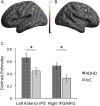Increase or Decrease of fMRI Activity in Adult Attention Deficit/ Hyperactivity Disorder: Does It Depend on Task Difficulty?
- PMID: 27207920
- PMCID: PMC5091824
- DOI: 10.1093/ijnp/pyw049
Increase or Decrease of fMRI Activity in Adult Attention Deficit/ Hyperactivity Disorder: Does It Depend on Task Difficulty?
Abstract
Background: Attention deficit/hyperactivity disorder has been shown to affect working memory, and fMRI studies in children and adolescents with attention deficit/hyperactivity disorder report hypoactivation in task-related attentional networks. However, studies with adult attention deficit/hyperactivity disorder patients addressing this issue as well as the effects of clinically valid methylphenidate treatment are scarce. This study contributes to closing this gap.
Methods: Thirty-five adult patients were randomized to 6 weeks of double-blind placebo or methylphenidate treatment. Patients completed an fMRI n-back working memory task both before and after the assigned treatment, and matched healthy controls were tested and compared to the untreated patients.
Results: There were no whole-brain differences between any of the groups. However, when specified regions of interest were investigated, the patient group showed enhanced BOLD responses in dorsal and ventral areas before treatment. This increase was correlated with performance across all participants and with attention deficit/hyperactivity disorder symptoms in the patient group. Furthermore, we found an effect of treatment in the right superior frontal gyrus, with methylphenidate-treated patients exhibiting increased activation, which was absent in the placebo-treated patients.
Conclusions: Our results indicate distinct activation differences between untreated adult attention deficit/hyperactivity disorder patients and matched healthy controls during a working memory task. These differences might reflect compensatory efforts by the patients, who are performing at the same level as the healthy controls. We furthermore found a positive effect of methylphenidate on the activation of a frontal region of interest. These observations contribute to a more thorough understanding of adult attention deficit/hyperactivity disorder and provide impulses for the evaluation of therapy-related changes.
Keywords: adult attention deficit/hyperactivity disorder; clinical trial; fMRI; methylphenidate; working memory.
© The Author 2016. Published by Oxford University Press on behalf of CINP.
Figures



Similar articles
-
Single-dose effects of methylphenidate and atomoxetine on functional connectivity during an n-back task in boys with ADHD.Psychopharmacology (Berl). 2023 Oct;240(10):2045-2060. doi: 10.1007/s00213-023-06422-7. Epub 2023 Jul 27. Psychopharmacology (Berl). 2023. PMID: 37500785 Free PMC article. Clinical Trial.
-
Functional magnetic resonance imaging of methylphenidate and placebo in attention-deficit/hyperactivity disorder during the multi-source interference task.Arch Gen Psychiatry. 2008 Jan;65(1):102-14. doi: 10.1001/archgenpsychiatry.2007.16. Arch Gen Psychiatry. 2008. PMID: 18180434 Clinical Trial.
-
Atomoxetine Treatment Strengthens an Anti-Correlated Relationship between Functional Brain Networks in Medication-Naïve Adults with Attention-Deficit Hyperactivity Disorder: A Randomized Double-Blind Placebo-Controlled Clinical Trial.Int J Neuropsychopharmacol. 2015 Sep 16;19(3):pyv094. doi: 10.1093/ijnp/pyv094. Int J Neuropsychopharmacol. 2015. PMID: 26377368 Free PMC article. Clinical Trial.
-
Immediate-release methylphenidate for attention deficit hyperactivity disorder (ADHD) in adults.Cochrane Database Syst Rev. 2021 Jan 18;1(1):CD013011. doi: 10.1002/14651858.CD013011.pub2. Cochrane Database Syst Rev. 2021. PMID: 33460048 Free PMC article.
-
Neurocognitive effects of methylphenidate in adults with attention-deficit/hyperactivity disorder: A meta-analysis.Neurosci Biobehav Rev. 2018 Jul;90:447-455. doi: 10.1016/j.neubiorev.2018.05.012. Epub 2018 May 8. Neurosci Biobehav Rev. 2018. PMID: 29751051 Review.
Cited by
-
Speech Processing Difficulties in Attention Deficit Hyperactivity Disorder.Front Psychol. 2019 Jul 5;10:1536. doi: 10.3389/fpsyg.2019.01536. eCollection 2019. Front Psychol. 2019. PMID: 31333549 Free PMC article.
-
Extended-release methylphenidate for attention deficit hyperactivity disorder (ADHD) in adults.Cochrane Database Syst Rev. 2022 Feb 24;2(2):CD012857. doi: 10.1002/14651858.CD012857.pub2. Cochrane Database Syst Rev. 2022. PMID: 35201607 Free PMC article.
-
Working memory training restores aberrant brain activity in adult attention-deficit hyperactivity disorder.Hum Brain Mapp. 2020 Dec;41(17):4876-4891. doi: 10.1002/hbm.25164. Epub 2020 Aug 19. Hum Brain Mapp. 2020. PMID: 32813290 Free PMC article. Clinical Trial.
-
Effect of methylphenidate on functional controllability: a preliminary study in medication-naïve children with ADHD.Transl Psychiatry. 2022 Dec 17;12(1):518. doi: 10.1038/s41398-022-02283-4. Transl Psychiatry. 2022. PMID: 36528602 Free PMC article. Clinical Trial.
-
Learning Experience Reverses Catecholaminergic Effects on Adaptive Behavior.Int J Neuropsychopharmacol. 2020 Mar 10;23(1):12-19. doi: 10.1093/ijnp/pyz058. Int J Neuropsychopharmacol. 2020. PMID: 31701133 Free PMC article. Clinical Trial.
References
-
- Adler LA, Faraone SV, Spencer TJ, Michelson D, Reimherr FW, Glatt SJ, Marchant BK, Biederman J. (2008) The reliability and validity of self- and investigator ratings of ADHD in adults. J Atten Disord 11: 711–719 . - PubMed
-
- American Psychiatric Association (2000) Diagnostic and statistical manual of mental disorders ( 4th ed., text rev.). Arlington, VA: : American Psychiatric Publishing; .
-
- Barkley RA. (1997) Behavioral inhibition, sustained attention, and executive functions: constructing a unifying theory of ADHD. Psychol Bull 121: 65–94 . - PubMed
-
- Bayerl M, Dielentheis TF, Vucurevic G, Gesierich T, Vogel F, Fehr C, Stoeter P, Huss M, Konrad A. (2010) Disturbed brain activation during a working memory task in drug-naive adult patients with ADHD. Neuroreport 21: 442 . - PubMed
LinkOut - more resources
Full Text Sources
Other Literature Sources
Miscellaneous

